People like us are most likely to stay far, far away from the beaches during the monsoon, which usually occur from October to March if we are talking about the east coast in Peninsular Malaysia. But like a secret world, when the monsoon season comes and the islands close their doors to the public; that is when the surfers come out to play. To the uninitiated, monsoon means persistent rain, angry winds and ferocious waves, but to the surfers, it’s just a good day to surf. Indeed, surfing is not my scene at all and it’s not until words got around that a Malaysian surfer won third place at the 2019 REnextop Asian Surfing Tour that prompted me to check out our surfing scenes. Malaysia is no Hawaii or Bali but our surfing spots have start making waves among surfers around the world, no pun intended. Let’s check out Malaysia’s top surfing spot.
Cherating, Pahang

Cherating, a small beach town about 45km north of Kuantan has been a surfing spot since the 80’s; but since surfing is not part of our culture, it has never been a sport enjoyed by the mass. Nowadays, we can see that the surfing community in Malaysia has grown bigger and stronger. There are even many surfing schools in Cherating.

I don’t speak the surfer’s language but from what I gather the waves in Cherating are consistent and are suitable for beginners, intermediate, advanced and longboard surfers. It’s a good place for beginners to learn surfing, while the more experienced surfers can enjoy a swell that goes up to five foot. For a “hodad” like us (a term surfer uses for a person who hangs around the beach and does not surf), there are also other activities to try your hands at such as turtle-watching, kayaking, kitesurfing and windsurfing.
How to get there:
By Bus
From Kuala Lumpur international airport (KLIA), take a train (KLIA Transit) to the Terminal Bersepadu Selatan (TBS) Bus Terminal – Check here : http://www.tbsbts.com.my. From TBS, please take a bus to Kemaman Town.
Kuala Lumpur (TBS) – Kuantan – Cherating – Kemaman Town – Kuala Terengganu – Kota Bahru . This is the normal route to east coast.
*note: Let the bus driver know that to drop you at Kampung Cherating Lama (Old Cherating Village).
By car
From Kuala Lumpur , just follow the east bound highway towards Kuantan and Kemaman. Normally, it takes about 3 hours to reach Cherating.
Pantai Batu Burok, Terengganu

The strong waves of the South China Sea makes the beaches and idyllic islands of Terengganu ideal for surfing. To the local and international surfers, Pantai Batu Burok is well-known for its beach breaks surfing. Over the last 10 years, various international surfing competitions have been held in Pantai Burok regularly, thus helping this beautiful sandy beaches with casuarina trees lining up the shore, to gain international recognition. In Terengganu, there are at least 15 other surf spots to be explored along the coast from Kemaman to Besut. Merang in Setiu, for example, is suited for point breaks, while Pulau Kapas is ideal for reef break surfing.

How to get there:
Batu Buruk and the surrounding beaches are easily reached from Kuala Terengganu by bus (Marang / Dungun), mini bus (No.14 / 13), trishaw and taxi or even on foot if you like walking (about 20 minutes from the city center). (www.backpackingmalaysia.com).
Desaru, Johor

Located in Kota Tinggi, Johor, Desaru has a few surfing spots that are worth mentioning. Among them are Pantai Desaru, Pantai Tanjung Balau, Pantai Sedili and Pantai Wild Boar.

Pantai Desaru is a great spot for beginners to learn to surf. The best time to surf here is in the early morning when the waves are in best condition with a less crowded beach.
Pantai Tanjung Balau is only 13-minute drive from Pantai Desaru and is home to a strong local surf community and even hosts its own international surfing competitions. Sandy breaks and three-foot-high waves make it an excellent spot to learn to surf.
Every surfing season, Pantai Sedili, a hidden beach located along the road of Sedili is always crowded with surfers especially during “good waves” day as the surfers called it. As the beach is quite isolated, you must bring your own food and drinks because there is no public facilities there.

Wild Boar Beach is the most secluded surfing spot compared to the other three beaches in Desaru. Aptly named after the local animal that resides in the area, the beach is so secluded that you need a local guide to show you the spot. Surfers have to bring their own food and water supply because the beach has zero facility but these inconvenience means nothing to them as long as they get to have a long uninterrupted ride on sandy breaks.
How to get there:
A one hour drive from Johor town, along with the way to Desaru, palm oil plantation can be seen and a bridge will be connecting the route to Desaru through the Senai Desaru expressway. Driving is recommended to get to Desaru because it is faster and convenient.
For public transportation to Desaru, there are direct Mara Liner coach services four times a day from Johor Bahru’s Larkin Bus Terminal to Bandar Penawar via Kota Tinggi. Besides that, there’s an option of taking a non-express bus from Larkin Bus Terminal (Maju 227 or Causeway Link 66) or from downtown Johor Bahru’s Jalan Wong Ah Fook (Transit Link 41, Maju 227, Causeway Link 6B; the bus stop is opposite City Square) to Kota Tinggi’s bus terminal (duration about 1h; Maju 227 one-way fare from City Square RM4.80; average frequency of Maju 227 is 15 min), and then take another bus from Kota Tinggi to Bandar Penawar (duration max. 1h, one-way fare RM4.50, frequency every 90 min). (Travelistaclub)
Tanjung Simpang Mengayau, Kudat, Sabah

Kudat in Sabah has long been a favourite surfing spots among Malaysian and Bruneian surfers. Located at the Tip of Borneo in Tanjung Simpang Mengayau, the Kalampunian Beach has waves that can reach up to 6 feet high with 50 to 100 meters ride. The type of break here is beach breaks and pointbreaks. It is an ideal spot for those with advanced surf skill set. But for the non-surfers, Kudat’ sandy beaches and crystal clear water is reason enough to hang around the beach; or maybe, just maybe you will be entertained by the tricks and twists of the surfers while chilling by the beach.

How to get there:
The Tip of Borneo is about 215 KM north of Kota Kinabalu. You need to drive about 2.5 to 3 hours on a paved road (with a few small sections of gravel road) to reach there (via Kota Kinabalu → Tuaran → Kota Belud main road). Or you can charter a taxi (can take 3 or 4 passengers) for a return trip for about RM240. (mysabah.com)
Tidal Bore of Sarawak

I wonder whether those experienced surfers dare to fight a tidal bore in Sri Aman’s Batang Lupar River, which is famed for its crocodile-infested waters. The tidal bore in Sri Aman, which is located 170km from Kuching is rated among the best bores in the world. A tidal bore may take on various forms, ranging from a single breaking wave front with a roller, somewhat like a hydraulic jump to undular bores, comprising a smooth wave front followed by a train of secondary wave (whelps). The tidal bore is a high wave caused by the meeting of two tides or by a tide rushing up the narrow river estuary. Its height depends on the time of the year, weather and phase of the moon. Sri Aman hosts the annual Tidal Bore festival known as ‘Pesta Benak’, normally held in the month of May.

How to get there:
To get to the town, board a bus at Kuching Sentral Transportation hub. The hub is a 5-minute drive from the Kuching International Airport and 20 minutes from Kuching City Centre. On average, it takes about four hours to travel by road from Kuching. Usually, bus will stop at the bazaar town of Lachau for toilet break.
Sunway Lagoon’s Surf Beach, Selangor

Sunway Lagoon’s Surf Beach is a man made wonder right here in the city where holiday makers all around the world come for a fun filled day in the sun. You can either laze in the beach or for the thrill seekers you can enjoy surfing or body boarding and beach volleyball. You can also show off your surfing skills on Malaysia’s only Surf Simulator or ‘FlowRider’*.
Stretching over 13,000 square meters, the Surf Beach is capable of churning out perfectly shaped waves up to the maximum height of eight-feet. The ability to condition the waves according to the needs of the surfers in terms of height, time and wave patterns make Surf Beach @ Sunway Lagoon a surfer’s paradise for both professional and aspiring surfers.
How to get there:
By Car
Sunway Lagoon is located in the bustling township of Sunway City, within the district of Petaling Jaya in the state of Selangor. It is a mere 15-minutes drive from Kuala Lumpur in smooth traffic conditions and is accessible via a network of expressways including the Federal Highway, Damansara-Puchong Expressway, New Pantai Expressway and KESAS Highway.
Surf Wall, Adventure Waterpark, Desaru Coast, Johor

A safe and high-energy surf simulator where surfing beginners or enthusiasts can catch and ride a radical artificial wave. The Surf Wall can accommodate up to five boogie boarders or two stand-up surfers at one time.
How to get there:
By Car
4 hours from Kuala Lumpur via the North-South Expressway.
By Air
1 hour from Kuala Lumpur to Senai International Airport with additional 1 hour for shuttle to Desaru Coast.
Suddenly I feel the urge to join the monsoon mayhem and pick up the surfboard myself. Paddle,paddle, paddle, and stand up… bruddah!
Featured image is courtesy of andiaceh/ombok











































